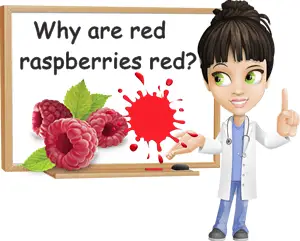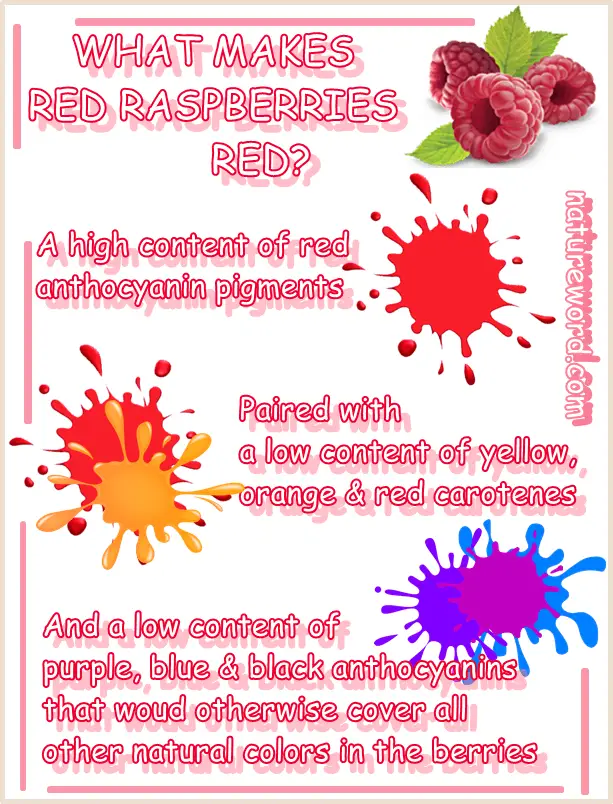What makes red raspberries red? Where does the red color in red raspberries come from? Why is it that red raspberries are red when ripe instead of another color? And what is the difference between red raspberries and other raspberry colors such as yellow, purple and black?
Where does the red color in red raspberries come from?
Ripe red raspberries owe their particular pink-red color to natural pigments that double as antioxidants. Predominantly the pigments that make red raspberries red when ripe are called anthocyanins. Anthocyanins are a class of flavonoid pigments responsible for colors such as pink, red, but also purple, blue and black. Anthocyanins color not just red raspberries, but also black raspberries and purple raspberries, and most of our food.

How do red raspberries come to be red?
Red raspberries start out a pale green color but turn a beautiful pink-red when ripe. Like all other foods with color, they are genetically predisposed to develop their particular pigment. But red raspberries are not always red. Or at least not all red raspberries come out red in the end.
There are red raspberries that turn yellow when they are ripe instead of red. The interesting turn of events is caused by a natural mutation in the fruit that inactivates the gene for the color red. As the gene for the color red becomes dormant, or non dominant, the resulting berries no longer develop a red pigmentation when ripe.
Then what happens is other natural pigments in the berries take over. In this case, yellow carotene pigments called xantophylls. Xanthophylls such as lutein and zeaxanthin are the reason why some red raspberries turn yellow instead of red when ripe. Find out more about where yellow raspberries come from.

Why are red raspberries red instead of another color?
How come red raspberries turn out red instead of yellow or pink or black or purple or green when ripe? What makes red raspberries red is both a high content of red-pigmented anthocyanin antioxidants and a low content of other lighter and stronger pigments such as yellow, orange, purple, blue or black.
For instance, if there were purple or blue pigments in red raspberries in equal to or higher amounts than red, then the berries wouldn’t be red when ripe but purple or blue instead. Darker pigments hide lighter ones. But when the gene for the color red is turned off in some red raspberries, the lighter pigments come out and the berries turn yellow or golden when ripe.
Red raspberries are highest in red anthocyanins, but also naturally have other pigments such as yellow, orange and red carotenes, just in far lower amounts. There are also constituents without pigment in the berry variety which contribute to the flavor profile and benefits for health, but not color.
When red raspberries cross with black raspberries, the resulting berries are a mix between the two dominant colors and come out purple. Find out more about what makes purple raspberries purple.
Red raspberries vs other raspberry colors
Red colored anthocyanins represent the dominant pigments in red raspberries and occur in the highest amounts. Red raspberries are also low in yellow and orange carotene pigments and very low in other anthocyanin pigments which allows the red to show through.
Vs red, yellow raspberries are high in yellow carotene pigments called xanthophylls (e.g. lutein, zeaxanthin). At the same time, they are low in all other pigments which allows the yellow color to show through as it cannot dominate other darker colors. In fact, according to research, yellow raspberry varieties have either very little anthocyanin pigmentation or none (there are different shades of the fruit available
– find out more about the color of yellow raspberries).
Compared to red, black raspberries are high in dark anthocyanin pigments that include red, purple, blue and black. This causes a very dark color in the ripe fruit that appears almost black.
Lastly, purple raspberries are a cross between red and black raspberries and have pigments from both varieties in varying amounts, depending on the cultivar. This results in different shades of purple in the ripe fruits. Purple raspberries range from a wine color to a deep purple with a reddish tinge to dark purple with bluish tones.
